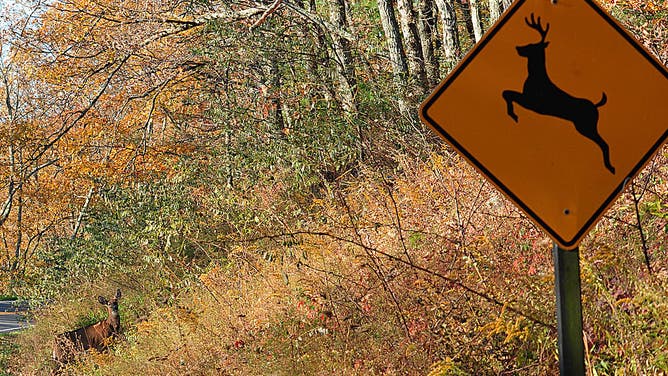A change to permanent daylight saving time would reduce deer collisions, study says
Fall is typically peak deer collision season in the U.S., costing upwards of $10 billion
Peak deer collision season in U.S.
Fox Weather's Will Nunley reports on the U.S. entering peak deer collision season.
The annual changing of the clocks to standard time will mean more than just earlier sunsets in the northern tier of the country, it will also mark the peak of deer collision season, which can be one of the deadliest times on U.S. roadways.
Researchers from the University of Washington report around 2.1 million deer-vehicle collisions happen each year, killing more than 400 people and costing upwards of $10 billion.
Biologists say it is during twilight around sunrise and sunset that deer are the most active and venture onto highways. These are also the times that many commuters hit the roadways to travel to and from school and work, leading to a deadly combination.
"Wildlife-vehicle collisions are a huge and growing problem," Calum Cunningham, a researcher at the University of Washington, said in a statement. "There are social costs — people killed and injured — and it’s also a conservation problem as it’s one of the largest sources of human-caused mortality of wildlife."
AS DAYLIGHT SHRINKS, US HEADS INTO PEAK DEER COLLISION SEASON
Researchers examined more than 1 million crashes since 1994 and found deer-vehicle collisions were 14 times more likely to occur in the two hours after sunset than in the two hours before, with nearly ten percent of all crashes occurring around the date of the switch from DST to standard time.
"We believe that this fall spike really happens due to the overlap of these two factors: the breeding season and the change from daylight saving time back to standard time," stated Laura Prugh, a wildlife professor at UW. "We don’t see a corresponding shift in deer-vehicle collisions in the spring during the other time change, and we believe that’s in part because spring is not a breeding season for deer."

A deer crosses at a "deer crossing" in the Shenandoah National Park November 1, 2008.
(KAREN BLEIER/AFP via Getty Images / Getty Images)
Making daylight saving time permanent could lead to reduction in crashes
Under federal law, standard time begins in November and will end on the second Sunday in March, but there has been a growing movement to stop the tradition.
Within the last few years, 19 states have either passed legislation or resolutions calling on the federal government to lift the limitations on required time changes, and a Senate bill dubbed the Sunshine Protection Act made it halfway through Congress.
An analysis done by WU researchers showed that if measures to abandon standard time were successful, thousands of fewer deer collisions would happen, resulting in fewer deaths and less property damage.
The study estimated 33 human lives could be saved, and more than $1 billion in vehicle damage would be prevented.
"Humans today have this ‘evening bias’ in our activity: we get up later and stay active later than what the sun is telling us to do," said Cunningham. "If people are thinking about what they can do for wildlife and for their own lives, reducing driving during dark hours is likely to help significantly."
10 THINGS TO CHANGE IN YOUR HOME WHEN YOU CHANGE YOUR CLOCKS
How to reduce the current risks of animal collisions
Fights for federal bills that would change regulations have regularly seen little action, and if the current bill before the U.S. House is not passed by the start of the new Congress, the measure will expire, and the process to pass the law will need to start over again.
A representative for the National Conference of State Legislatures said it could be some time before any measure is passed by Congress and ultimately signed by the president.
In the meantime, AAA suggests following their advice to get to your destination safely during the deer season:
- Scan the road ahead
- Use beam headlights if there is no oncoming traffic
- Be extra cautious at dawn and dusk
- If a collision is unavoidable, apply the brakes firmly and remain in your lane
